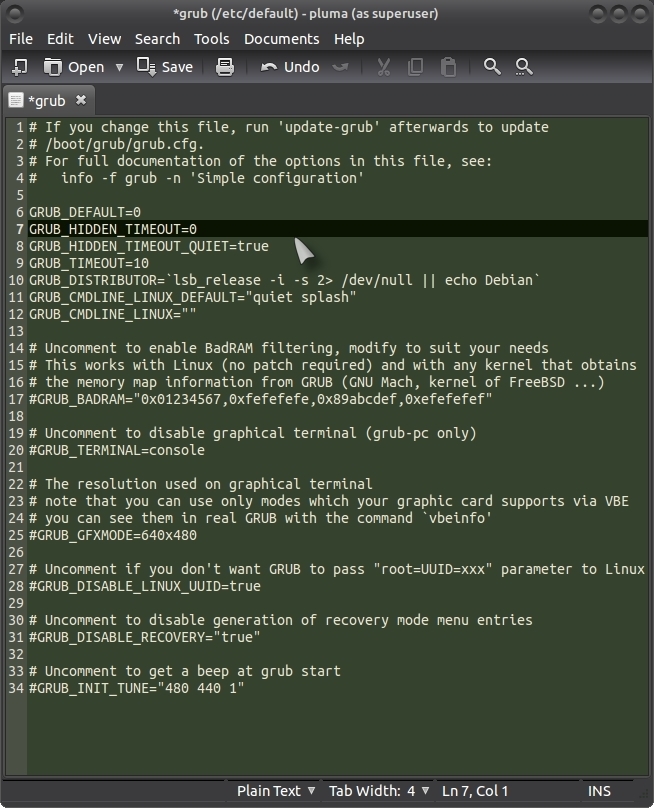

- #GRUB DISPLAY MENU HOW TO#
- #GRUB DISPLAY MENU DRIVER#
- #GRUB DISPLAY MENU WINDOWS 10#
- #GRUB DISPLAY MENU PASSWORD#
How to install the NVIDIA drivers on Ubuntu 18.

#GRUB DISPLAY MENU PASSWORD#
Set Kali root password and enable root login.How to change from default to alternative Python version on Debian Linux First of all I want to clear something This issue has nothing to do with your graphics card It is all about the resolution of your displays (Either the laptop or the external display) For Example - If your laptop screen is set 1360x768 but your external display is 1600x900 In order to show the grub menu or the BIOS of your laptop on the external display simply set the external display's.Netplan static IP on Ubuntu configuration.How to enable/disable firewall on Ubuntu 18.04 Bionic Beaver Linux.How to install Tweak Tool on Ubuntu 20.04 LTS Focal Fossa Linux.Linux IP forwarding – How to Disable/Enable.If you have a friendly relationship with systemd you can see what happens in emergency mode by viewing the /usr/lib/systemd/system/rvice file. Then add '' to the end of the kernel option. How to use bash array in a shell script To boot into emergency mode, enter the setup edit display by typing 'e' in the grub2 menu.
#GRUB DISPLAY MENU DRIVER#
#GRUB DISPLAY MENU WINDOWS 10#
Ubuntu 20.04 Remote Desktop Access from Windows 10.How to find my IP address on Ubuntu 20.04 Focal Fossa Linux.How to install the NVIDIA drivers on Ubuntu 20.04 Focal Fossa Linux.Generate a new grub config file (on Debian based systems, an alternative to the below command is update-grub).Chroot into the installed system in order to reconfigure grub.Use fdisk -l if you’re not sure of the correct name. Once you are booted into the live environment, open up a terminal and type the following commands. If you are brought to the grub rescue> prompt when booting your computer, you’ll need to use live media to help repair your system. Once loaded into your system, finish repairing Grub by remaking the config file and reinstalling Grub.Once you have set the root partition, Linux kernel, and initrd image file, you should be able to successfully boot into your Linux distro.Use tab completion to help select the right Linux kernel and image file, and fdisk -l command to get the correct device name. Depending on your distribution and configuration, these values may be different for you. For our example, we’ll be using (hd0,msdos1) as our root partition, /boot/vmlinuz as our Linux kernel, /boot/initrd.img as our image file, and /dev/sda1 as our device name. Once you have determined the correct partition, you can set it as root with the following commands.Lost+found var/ dev/ run/ etc/ tmp/ sys/ proc/ usr/ bin boot/ home/ lib lib64 mnt/ opt/ root/ sbin srv/ This will help you indentify which partition you want to boot into. You can see the files of any partition by using another ls command.Depending on your configuration, you may see multiple hard drives or partitions in this listing. Start by doing a simple ls listing to see what partitions are available.Should you press ESC at the editor or command line screens all configuration changes you made are discarded and you’re plonked back at the main menu interface.When you get to a grub> prompt, you can use the following commands as an attempt to fix your boot loader and get booted back into your Linux distro. Both GRUB and LiLo can be configured to display this menu for a short period of time, to display it only in response to specific keyboard input (such as. Tap the ‘Esc’ key at any time to return to the main GRUB Menu screen. From here you can do a wealth of things, including changing menu entry names, fixing a broken install, or booting into a custom kernel configuration. Press the ‘c’ key at the GRUB Menu to switch into ‘CLI Mode’. When you’re ready to boot with your modified changes press Ctrl+X. You may need to do this to run a specific boot parameter, pass a kernel flag, adjust the run time level or set the frame buffer mode. Use the arrow keys to select a boot option and hit the ‘e’ key to that entry’s boot options by hand. There may be times you need to edit a boot command, When you’ve selected the one you wish to highlight press Enter to boot it. When you are at the GRUB menu you can use the Up and Down arrow keys to select other operating systems and kernel configurations display in the menu. To see GRUB during boot you need to press the right-hand SHIFT key during boot. Ubuntu does not display the GRUB menu by default. So, for this entry in our Ubuntu Basics series, we’re going to look at how to navigate around GRUB and what options are available. GRUB remains a vital part of the Linux ecosystem, whether you intend to make use of it or not. These days you only tend to see it when something has gone wrong with your install! Once upon a time it was shown on every boot. We don’t see as much of GRUB, the boot loader that is installed with Ubuntu, as we used to. The Grub bootloader is a package that is used to boot various operating systems via a menu upon computer system boot-up.


 0 kommentar(er)
0 kommentar(er)
